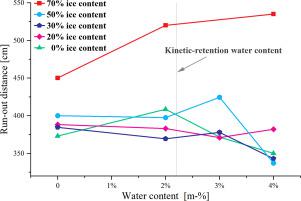Engineering Geology ( IF 6.9 ) Pub Date : 2021-02-27 , DOI: 10.1016/j.enggeo.2021.106072 Yuhao Ren , Qingqing Yang , Qiangong Cheng , Fei Cai , Zhiman Su

|
Rock-ice avalanches pose serious risks to humans and infrastructures due to their extremely large volumes and high mobility in glacierized mountain regions. The mobility of rock-ice avalanches is supposed to be influenced by water, while the solid-liquid interactions induced by minor wetting remain an open issue. A series of flume tests was performed to investigate the influence of a small amount of water (no more than 4% of the gravel weight) on the behavior and mobility of gravel-ice mixtures. The test results show that intergranular refreezing bonds were created with a preliminary addition of water. The breakup of some weak refreezing bonds during particle rearrangement likely dissipated some kinetic energy, and thus, the mixture mobility was reduced. As the water content increased, the thermal conductivity could likely not remain efficient enough to refreeze all the trapped water and thus allowed unfrozen water to lubricate particle corners, which enhanced mixture mobility. With a further increase in the water content, suction-induced cohesion cemented particles as clusters and reduced mixture mobility. However, a high ice content resulted in mobility enhancement with increasing water content because more gravel was refrozen into the ice matrix, and thus, the basal friction was lowered by the occupation of ice cubes at the bottom. The redistribution pattern of trapped water during mass propagation changed at a characteristic water content. When the water content was lower than the characteristic content, superficially cohered water detached from the surface asperity of one particle and transferred to another during particle rearrangement, i.e., local redistribution of trapped water. When the water content was higher than the characteristic content, the downward transfer of a considerable amount of trapped water was triggered by particle rearrangement under the influence of gravity, i.e., bulk redistribution of trapped water. The water experiencing bulk redistribution influenced the mixture mobility by exerting intergranular drag force via the build-up and break-up of liquid bridges, while locally redistributed water influenced mixture mobility by altering the surface properties of particles. This study is expected to be helpful in better understanding the propagation mechanisms of water-poor rock-ice avalanches and in improving relevant hazard assessments.
中文翻译:

砾石冰混合物中少量润湿引起的固液相互作用:岩冰雪崩流动性的关键因素
由于冰山雪崩的数量巨大且在冰川山区的流动性很高,因此雪崩对人类和基础设施构成了严重的风险。岩石冰雪崩的流动性应该受到水的影响,而由少量润湿引起的固液相互作用仍然是一个悬而未决的问题。进行了一系列的水槽测试,以调查少量水(不超过砾石重量的4%)对砾石冰混合物的行为和流动性的影响。测试结果表明,通过预先添加水可以形成晶间再冷冻键。粒子重排过程中一些弱的冷冻键的断裂可能耗散了一些动能,因此降低了混合物的迁移率。随着水含量的增加,导热性可能无法保持足够高的效率以重新冻结所有捕获的水,从而使未冻结的水润滑颗粒角,从而增强了混合物的流动性。随着水含量的进一步增加,吸力引起的内聚力将颗粒粘合为团簇并降低了混合物的流动性。但是,较高的冰含量会导致水分含量增加而导致流动性增强,因为更多的砾石会重新凝结到冰基质中,因此,底部的冰块占据了基础摩擦力,从而降低了摩擦力。在质量传播过程中,截留的水的重新分布模式会随着特征水含量而变化。当水含量低于特征含量时,表面凝聚的水从一个粒子的表面凹凸不平处脱离,并在粒子重排期间(即,所捕集的水在局部重新分布)转移到另一个粒子上。当水含量高于特征含量时,在重力的影响下,即颗粒的重新分布,大量的捕集水的向下转移是由颗粒重排触发的。经历块体重新分布的水通过液桥的建立和破坏而施加晶间拖曳力,从而影响混合物的流动性,而局部重新分布的水通过改变颗粒的表面性质影响混合物的流动性。











































 京公网安备 11010802027423号
京公网安备 11010802027423号